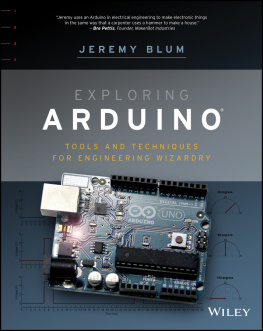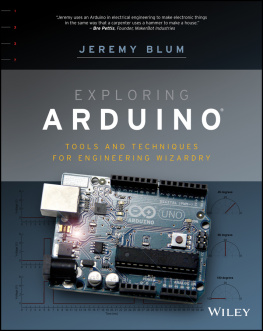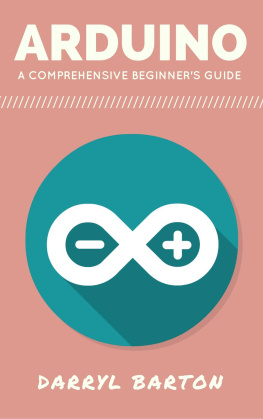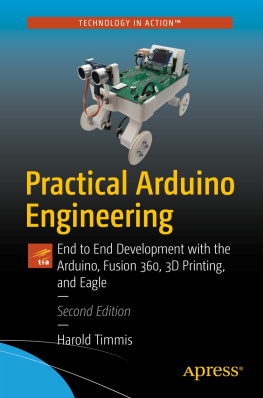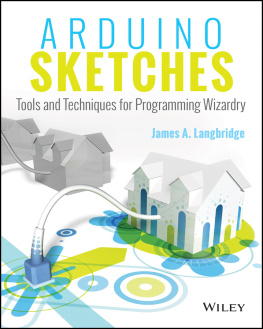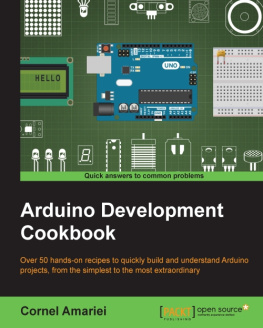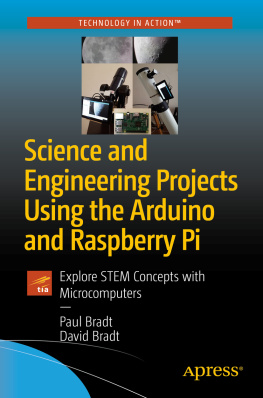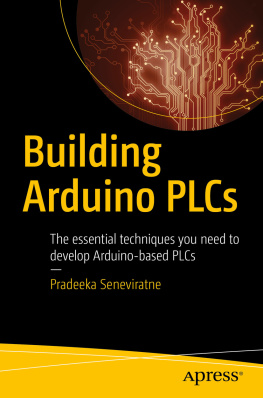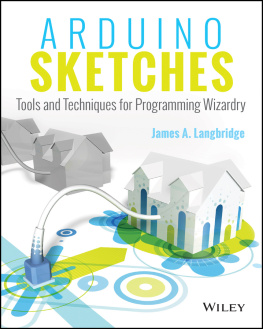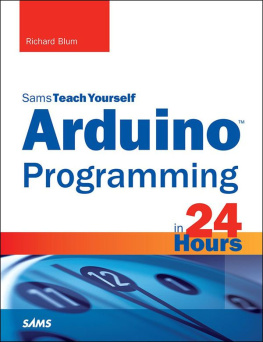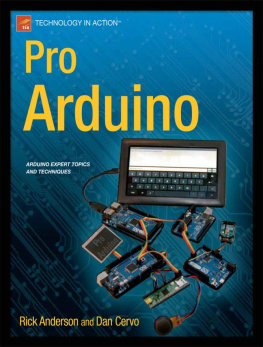Jeremy Blum - Exploring Arduino: Tools and Techniques for Engineering Wizardry
Here you can read online Jeremy Blum - Exploring Arduino: Tools and Techniques for Engineering Wizardry full text of the book (entire story) in english for free. Download pdf and epub, get meaning, cover and reviews about this ebook. year: 2013, publisher: John Wiley & Sons, Inc., genre: Computer. Description of the work, (preface) as well as reviews are available. Best literature library LitArk.com created for fans of good reading and offers a wide selection of genres:
Romance novel
Science fiction
Adventure
Detective
Science
History
Home and family
Prose
Art
Politics
Computer
Non-fiction
Religion
Business
Children
Humor
Choose a favorite category and find really read worthwhile books. Enjoy immersion in the world of imagination, feel the emotions of the characters or learn something new for yourself, make an fascinating discovery.
- Book:Exploring Arduino: Tools and Techniques for Engineering Wizardry
- Author:
- Publisher:John Wiley & Sons, Inc.
- Genre:
- Year:2013
- Rating:4 / 5
- Favourites:Add to favourites
- Your mark:
- 80
- 1
- 2
- 3
- 4
- 5
Exploring Arduino: Tools and Techniques for Engineering Wizardry: summary, description and annotation
We offer to read an annotation, description, summary or preface (depends on what the author of the book "Exploring Arduino: Tools and Techniques for Engineering Wizardry" wrote himself). If you haven't found the necessary information about the book — write in the comments, we will try to find it.
Exploring Arduino: Tools and Techniques for Engineering Wizardry — read online for free the complete book (whole text) full work
Below is the text of the book, divided by pages. System saving the place of the last page read, allows you to conveniently read the book "Exploring Arduino: Tools and Techniques for Engineering Wizardry" online for free, without having to search again every time where you left off. Put a bookmark, and you can go to the page where you finished reading at any time.
Font size:
Interval:
Bookmark:
In This Part
- Chapter 1: Getting Up and Blinking with the Arduino
- Chapter 2: Digital Inputs, Outputs, and Pulse-Width Modulation
- Chapter 3: Reading Analog Sensors
Parts Youll Need for This Chapter:
CODE AND DIGITAL CONTENT FOR THIS CHAPTER
Code downloads, videos, and other digital content for this chapter can be found at www.exploringarduino.com/content/ch1 .In addition, all code can be found at www.wiley.com/go/exploringarduino on the Download Code tab. The code is in the chapter 01 download and individually named according to the names throughout the chapter.
Now that you have some perspective on the Arduino platform and its capabilities, its time to explore your options in the world of Arduino. In this chapter, you examine the available hardware, learn about the programming environment and language, and get your first program up and running. Once you have a grip on the functionality that the Arduino can provide, youll write your first program and get the Arduino to blink!
In your adventures with the Arduino, youll depend on three main components for your projects:
- The Arduino board itself
- External hardware (including both shields and hand-made circuits, which youll explore throughout this book)
- The Arduino integrated development environment, or Arduino IDE
All these system components work in tandem to enable you do just about anything with your Arduino.
You have a lot of options when it comes to Arduino development boards, but this book focuses on using official Arduino boards. Because the boards are all designed to be programmable via the same IDE, you can generally use any of the modern Arduino boards to complete the projects in this book with zero or minor changes. However, when necessary, youll see caveats about using different boards for various projects. The majority of the projects use the Arduino Uno.
You start by exploring the basic functionality baked in to every Arduino board. Then you examine the differences between each modern board so that you can make an informed decision when choosing a board to use for your next project.
All Arduino boards have a few key capabilities and functions. Take a moment to examine the Arduino Uno (see ); it will be your base configuration. These are some key components that youll be concerning yourself with:
- Atmel microcontroller
- USB programming/communication interface(s)
- Voltage regulator and power connections
- Breakout I/O pins
- Debug, Power, and RX/TX LEDs
- Reset button
- In-circuit serial programmer (ICSP) connector(s)
Arduino Uno components
Credit: Arduino, www.arduino.cc
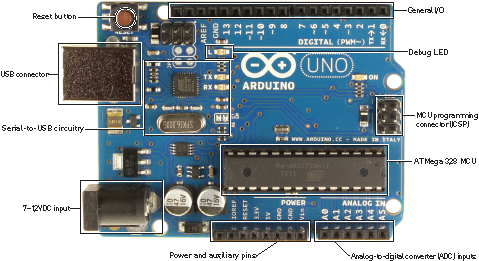
At the heart of every Arduino is an Atmel microcontroller unit (MCU). Most Arduino boards, including the Arduino Uno, use an AVR ATMega microcontroller. The Arduino Uno in uses an ATMega 328p. The Due is an exception; it uses an ARM Cortex microcontroller. This microcontroller is responsible for holding all of your compiled code and executing the commands you specify. The Arduino programming language gives you access to microcontroller peripherals, including analog-to-digital converters (ADCs), general-purpose input/output (I/O) pins, communication buses (including I2C and SPI), and serial interfaces. All of this useful functionality is broken out from the tiny pins on the microcontroller to accessible female headers on the Arduino that you can plug wires or shields into. A 16 MHz ceramic resonator is wired to the ATMegas clock pins, which serves as the reference by which all program commands execute. You can use the Reset button to restart the execution of your program. Most Arduino boards come with a debug LED already connected to pin 13, which enables you to run your first program (blinking an LED) without connecting any additional circuitry.
Ordinarily, ATMega microcontroller programs are written in C or Assembly and programmed via the ICSP interface using a dedicated programmer (see ). Perhaps the most important characteristic of an Arduino is that you can program it easily via USB, without using a separate programmer. This functionality is made possible by the Arduino bootloader. The bootloader is loaded onto the ATMega at the factory (using the ICSP header), which allows a serial USART (Universal Synchronous/Asynchronous Receiver/Transmitter) to load your program on the Arduino without using a separate programmer. (You can learn more about how the bootloader functions in The Arduino Bootloader and Firmware Setup sidebar.)
In the case of the Arduino Uno and Mega 2560, a secondary microcontroller (an ATMega 16U2 or 8U2 depending on your revision) serves as an interface between a USB cable and the serial USART pins on the main microcontroller. The Arduino Leonardo, which uses an ATMega 32U4 as the main microcontroller, has USB baked right in, so a secondary microcontroller is not needed. In older Arduino boards, an FTDI brand USB-to-serial chip was used as the interface between the ATMegas serial USART port and a USB connection.
AVR ISP MKII programmer
Credit: 2013 Atmel Corporation. All rights reserved.
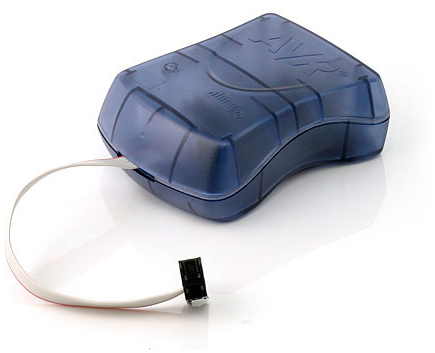
The part of the Arduino that youll care the most about during your projects is the general-purpose I/O and ADC pins. All of these pins can be individually addressed via the programs youll write. All of them can serve as digital inputs and outputs. The ADC pins can also act as analog inputs that can measure voltages between 0 and 5V (usually from resistive sensors). Many of these pins are also multiplexed to serve additional functions, which you will explore during your projects. These special functions include various communication interfaces, serial interfaces, pulse-width-modulated outputs, and external interrupts.
For the majority of your projects, you will simply use the 5V power that is provided over your USB cable. However, when youre ready to untether your project from a computer, you have other power options. The Arduino can accept between 6V and 20V (7-12V recommend) via the direct current (DC) barrel jack connector, or into the Vin pin. The Arduino has built-in 5V and 3.3V regulators:
- 5V is used for all the logic on the board. In other words, when you toggle a digital I/O pin, you are toggling it between 5V and 0V.
- 3.3V is broken out to a pin to accommodate 3.3V shields and external circuitry.
Font size:
Interval:
Bookmark:
Similar books «Exploring Arduino: Tools and Techniques for Engineering Wizardry»
Look at similar books to Exploring Arduino: Tools and Techniques for Engineering Wizardry. We have selected literature similar in name and meaning in the hope of providing readers with more options to find new, interesting, not yet read works.
Discussion, reviews of the book Exploring Arduino: Tools and Techniques for Engineering Wizardry and just readers' own opinions. Leave your comments, write what you think about the work, its meaning or the main characters. Specify what exactly you liked and what you didn't like, and why you think so.

